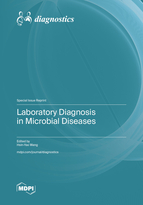Laboratory Diagnosis in Microbial Diseases
A special issue of Diagnostics (ISSN 2075-4418). This special issue belongs to the section "Diagnostic Microbiology and Infectious Disease".
Deadline for manuscript submissions: closed (31 July 2023) | Viewed by 26530
Special Issue Editor
Interests: laboratory medicine; medical AI; translational medicine
Special Issues, Collections and Topics in MDPI journals
Special Issue Information
Dear Colleagues,
The current diagnosis of infectious diseases largely depends on conventional phenotypic tools. However, typically the phenotypic tools are heavily based on culture and susceptible to bias in testing handling. Specifically, phenotypic result is the final phenomenon of protein expression in vitro. The details of genomics and proteomics cannot be seen in the conventional phenotypic assays. What we can see now is just the tip of the iceberg of infectious diseases. Thus, I would like to invite outstanding researchers in the community to contribute your excellent studies to the Special Issue. The targeted articles include, but not limited to, genomic or proteomic researches focusing broadening our view on infectious diseases. I believe these will form the fundamental basis and considerable impact on further precise measurement of infectious diseases.
Dr. Hsin-Yao Wang
Guest Editor
Manuscript Submission Information
Manuscripts should be submitted online at www.mdpi.com by registering and logging in to this website. Once you are registered, click here to go to the submission form. Manuscripts can be submitted until the deadline. All submissions that pass pre-check are peer-reviewed. Accepted papers will be published continuously in the journal (as soon as accepted) and will be listed together on the special issue website. Research articles, review articles as well as short communications are invited. For planned papers, a title and short abstract (about 100 words) can be sent to the Editorial Office for announcement on this website.
Submitted manuscripts should not have been published previously, nor be under consideration for publication elsewhere (except conference proceedings papers). All manuscripts are thoroughly refereed through a single-blind peer-review process. A guide for authors and other relevant information for submission of manuscripts is available on the Instructions for Authors page. Diagnostics is an international peer-reviewed open access semimonthly journal published by MDPI.
Please visit the Instructions for Authors page before submitting a manuscript. The Article Processing Charge (APC) for publication in this open access journal is 2600 CHF (Swiss Francs). Submitted papers should be well formatted and use good English. Authors may use MDPI's English editing service prior to publication or during author revisions.
Keywords
- genomics
- proteomics
- diagnostics
- infections
Related Special Issue
- 2nd Edition: Laboratory Diagnosis in Microbial Diseases in Diagnostics (4 articles)







